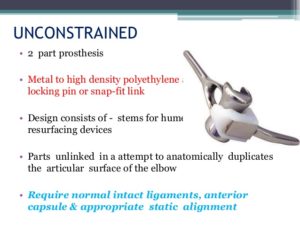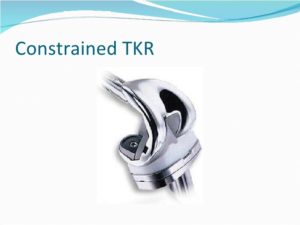
Polyethylene wear total knee joints
Contents:
- polyethylene synovitis
- constrained and unconstrained total knee models
- wear of the polyethylene
- ceramic surfaces, use of hard joint surfaces to avoid the wear problems
Total knee prostheses have polyethylene components – the tibial and patellar joint surfaces.
The polyethylene surfaces of the total knees suffer wear damages. Wear removes polyethylene material from the polyethylene components. As the wear progresses, the polyethylene components become successively more and more thin.
In some cases of the rapid polyethylene wear, the metallic femoral component wore through the tibial plate during a few years.
Although the thinning of the polyethylene components may lead to their ultimate destruction and thus result in a total knee prosthesis failure, more total knee prosthesis failures are caused by the release of excessive quantities of polyethylene wear particles. These particles then trigger a biologic reaction that eventually destructs the fixation of the total knee prosthesis to the skeleton.
Polyethylene induced knee synovitis.
One complication caused by increased quantities of polyethylene wear particles is a special form of total knee joint inflammation called polyethylene synovitis. The lining around the total knee joint becomes inflamed due to irritation from many particles of polyethylene that are floating in the joint fluid.
These patients experience:
- pain in the replaced knee,
- swollen knee joint with signs of increased volume of joint fluid
- X-ray changes, demonstrating increased wear of the PE components
Samples of joint fluid taken from these patients showed that the joint fluid was laden with polyethylene particles scratched from the polyethylene joint surfaces.
Loosening
(constrained range of motion as a cause)
More important complication of the total knee replacement associated with excessive release of polyethylene particles is loosening of the prosthesis.
Studies have indicated that among the many important factors that influence the wear of polyethylene in a total knee joint, the design of the total knee prosthesis is of considerable importance.
The surgeon who designs a total knee prosthesis for a low wear is facing a dilemma.
- He may design a total knee model with almost unrestricted range of motion, but with high wear rates of polyethylene component or
- He may design a total knee model with lower rates of polyethylene component but with restricted range of motion
Unconstrained designs

Designs where a flat tibial plate articulates with round femoral condyles component do not constrain the rotation movements in the knee.
These designs mimic the motion of a healthy knee joint better. But these designs have smaller contact areas between the tibial and the femoral components, generate higher stresses in the polyethylene plate, and produce more polyethylene wear particles.
Constrained designs

Designs of a total knee prosthesis where a tibial plate has deep concave recesses that are conforming (congruent) with round femoral condyles constrain the rotation movements in the knee.
Constrained total knee designs have large contact areas between the tibial and the femoral components, generate lower stresses in the polyethylene plate, and produce less polyethylene wear particles.
In constricted total knee designs, however, the movements of the femoral condyles are restricted to a hinge-like movements. These constrained designs cannot accommodate for the large range of motion produced in the knee joint during gait and other activities. Stresses created by the restriction of rotation movements propagate to the interface between the prosthesis and the skeleton with increased risk for prosthetic loosening.
One way to diminish the wear problems is to increase the contact areas of the bearing surfaces of the total knee without diminishing the range of motion in the total knee joint.
As yet, the surgeons developed two clever designs to increase the contact areas of the total knee joint:
- the mobile bearing total knee prosthesis
- the posterior stabilized total knee prosthesis.
The character of polyethylene wear
Studies demonstrate that the wear of polyethylene components in total knees has another character than the wear in total hip prostheses.
The stresses on the polyethylene surface of a total knee joint cause damage to the polyethylene component one to two millimeters under the component’s joint surface. The polyethylene undergoes a fatigue failure one to two millimeters under the joint surfaces and “fractures”. Relatively large wear particles of polyethylene are then abraded from the joint surface.
This fatigue damage may result in quick destruction of the whole polyethylene component. Many scientists now believe that new forms of UHMW polyethylene cannot prevent this form of polyethylene damage in total knees. They believe that only new models of total knee prostheses with more conforming surfaces may solve the problem of PE wear in total knee joints.
Use of hard joint surfaces to avoid the wear problems.
(ceramics)
Another way to reduce the wear of polyethylene component is to choose suitable material combinations for the bearing joint surfaces.
In a ball and socket joints, such as the hip joint, with congruent joint surfaces, all moving artificial joint surfaces may be fabricated from hard materials and the use of the “soft” polyethylene with wear problems may be avoided altogether.
Unfortunately, the knee joints, both natural and artificial, have very incongruent joint surfaces. For such joints the use of two hard joint surfaces, for example ceramic-on-ceramic or metal-on-metal, would produce extremely high stresses in these materials. The high stresses would then destruct the artificial surfaces mechanically.
So as yet, it seems that the use of a polyethylene component in the total knee joint seems unavoidable.
It is, however, known that ceramic-on-polyethylene bearing surface reduces the production of polyethylene wear particles as compared with the metal-on-polyethylene bearing surface. But also this way is difficult because there are technical problems with fabrication of large artificial joint components made from ceramic.
There are only two total knee joint designs where a ceramic femoral component articulates with a polyethylene tibial component present on the market at present. Laboratory experiments show that such designs have lower rates of polyethylene wear compared to metal-on-polyethylene surface combinations. See also the chapter Outline of the total knee prosthesis